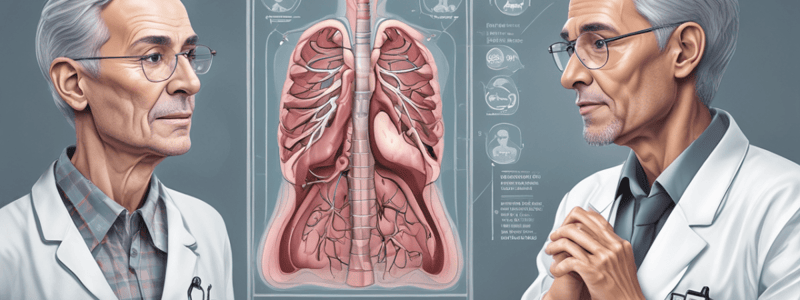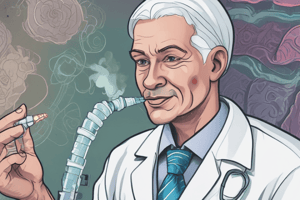Podcast
Questions and Answers
What is a primary purpose of establishing a rapport with the patient during the interview?
What is a primary purpose of establishing a rapport with the patient during the interview?
- To determine the effectiveness of therapy
- To build trust and collect diagnostic information (correct)
- To diagnose a pulmonary disease
- To obtain payment plans
In which space should the clinician conduct the patient interview?
In which space should the clinician conduct the patient interview?
- Personal space (correct)
- Critical space
- Social space
- Intimate space
What is a characteristic of a leading question?
What is a characteristic of a leading question?
- It is vague and unclear
- It is open-ended and encourages elaboration
- It is specific and objective
- It leads the patient towards a desired response (correct)
What is a benefit of collecting diagnostic information through the patient interview?
What is a benefit of collecting diagnostic information through the patient interview?
What is a purpose of monitoring changes in the patient's symptoms and response to therapy?
What is a purpose of monitoring changes in the patient's symptoms and response to therapy?
Why is it essential to avoid leading questions during the patient interview?
Why is it essential to avoid leading questions during the patient interview?
What is the most common location of pulmonary infarctions associated with thromboembolic obstruction?
What is the most common location of pulmonary infarctions associated with thromboembolic obstruction?
Which of the following is not a pathophysiologic change associated with pulmonary embolism?
Which of the following is not a pathophysiologic change associated with pulmonary embolism?
What is the primary cause of death from massive pulmonary embolism?
What is the primary cause of death from massive pulmonary embolism?
What is a contributing factor to the development of hypoxemia in a patient with pulmonary emboli?
What is a contributing factor to the development of hypoxemia in a patient with pulmonary emboli?
What is the name of the two blood supplies to the lung?
What is the name of the two blood supplies to the lung?
What is the usual presentation of pulmonary infarction on chest images?
What is the usual presentation of pulmonary infarction on chest images?
What type of lung disease is typically associated with a dry, nonproductive cough?
What type of lung disease is typically associated with a dry, nonproductive cough?
What is the term used to describe mucus from the tracheobronchial tree that has not been contaminated by oral secretions?
What is the term used to describe mucus from the tracheobronchial tree that has not been contaminated by oral secretions?
What is the term used to describe sputum that contains pus cells?
What is the term used to describe sputum that contains pus cells?
What is the term used to describe coughing up blood or blood-streaked sputum from the lungs?
What is the term used to describe coughing up blood or blood-streaked sputum from the lungs?
What is a characteristic of pleuritic chest pain?
What is a characteristic of pleuritic chest pain?
Which of the following is a characteristic of restrictive lung disease?
Which of the following is a characteristic of restrictive lung disease?
What is the primary cause of pedal edema?
What is the primary cause of pedal edema?
What is the result of coronary artery occlusion?
What is the result of coronary artery occlusion?
Why does tachypnea occur with significant fever?
Why does tachypnea occur with significant fever?
What is included in a patient's past medical history?
What is included in a patient's past medical history?
What is an element of a patient's social and environmental history?
What is an element of a patient's social and environmental history?
What is a common respiratory change seen in patients with significant fever?
What is a common respiratory change seen in patients with significant fever?
What is the primary focus of the family and social/environmental history part of the medical history?
What is the primary focus of the family and social/environmental history part of the medical history?
Which of the following pulmonary disorders is not believed to have a genetic link?
Which of the following pulmonary disorders is not believed to have a genetic link?
What is the term used to describe excessive sweating?
What is the term used to describe excessive sweating?
Which of the following is not a possible cause of diaphoresis?
Which of the following is not a possible cause of diaphoresis?
What is a characteristic of diaphoresis?
What is a characteristic of diaphoresis?
What is the primary cause of tachypnea in patients with significant fever?
What is the primary cause of tachypnea in patients with significant fever?
Which of the following is not associated with diaphoresis?
Which of the following is not associated with diaphoresis?
What is the most common cause of pedal edema?
What is the most common cause of pedal edema?
What is included in a patient's past medical history?
What is included in a patient's past medical history?
What is the primary focus of the family and social/environmental history part of the medical history?
What is the primary focus of the family and social/environmental history part of the medical history?
Which of the following pulmonary disorders is believed to have a genetic link?
Which of the following pulmonary disorders is believed to have a genetic link?
What is the result of coronary artery occlusion?
What is the result of coronary artery occlusion?
What is a characteristic of diaphoresis?
What is a characteristic of diaphoresis?
What is an element of a patient's social and environmental history?
What is an element of a patient's social and environmental history?
What is a critical element of a patient's medical history?
What is a critical element of a patient's medical history?
Which of the following is included in a patient's family and social/environmental history?
Which of the following is included in a patient's family and social/environmental history?
Flashcards
Patient Interview Purposes
Patient Interview Purposes
Establish rapport, collect diagnostic information, and monitor therapy response.
Appropriate Interview Space
Appropriate Interview Space
2 to 4 feet from the patient.
Leading Questions
Leading Questions
Questions that suggest the answer, skewing patient responses.
Blood Supply Types (Lungs)
Blood Supply Types (Lungs)
Signup and view all the flashcards
Pulmonary Infarction Location
Pulmonary Infarction Location
Signup and view all the flashcards
Massive Pulmonary Embolism Consequence
Massive Pulmonary Embolism Consequence
Signup and view all the flashcards
Pathophysiologic Changes
Pathophysiologic Changes
Signup and view all the flashcards
Hypoxemia Cause
Hypoxemia Cause
Signup and view all the flashcards
Phlegm
Phlegm
Signup and view all the flashcards
Purulent Sputum
Purulent Sputum
Signup and view all the flashcards
Hemoptysis Definition
Hemoptysis Definition
Signup and view all the flashcards
Pleuritic Chest Pain
Pleuritic Chest Pain
Signup and view all the flashcards
Respiratory Rate with Fever
Respiratory Rate with Fever
Signup and view all the flashcards
Common Cause of Pedal Edema
Common Cause of Pedal Edema
Signup and view all the flashcards
Patient's Past Medical History
Patient's Past Medical History
Signup and view all the flashcards
Social/Environmental History
Social/Environmental History
Signup and view all the flashcards
Diaphoresis Associations
Diaphoresis Associations
Signup and view all the flashcards
Study Notes
Patient Interview Purposes
- Interviews help establish rapport between clinician and patient.
- Essential diagnostic information is collected during interviews.
- Monitoring changes in symptoms and therapy response occurs through patient interviews.
Appropriate Interview Space
- Conduct interviews in personal space, typically 2 to 4 feet from the patient.
Leading Questions
- Example of a leading question: "Is your breathing better now?" can skew patient responses.
Blood Supply Types
- The lungs receive blood from two sources: pulmonary arterial circulation and bronchial circulation.
Pulmonary Infarction Location
- Most pulmonary infarctions associated with thromboembolic obstruction occur at the lung bases, often appearing as wedge-shaped opacities on imaging.
Massive Pulmonary Embolism Consequence
- Death from massive pulmonary embolism typically results from cardiovascular collapse rather than respiratory failure.
Pathophysiologic Changes in Pulmonary Embolism
- Not typically associated with pulmonary embolism: decreased ciliary mobility.
- Associated changes: increased dead space ventilation and bronchoconstriction.
Conditions Contributing to Hypoxemia
- Intrapulmonary shunt is a significant factor for hypoxemia in pulmonary embolism patients.
Tracheobronchial Secretions
- Secretions not contaminated by oral secretions are termed phlegm.
Purulent Sputum
- Sputum containing pus is classified as purulent, often indicating a bacterial infection.
Hemoptysis Definition
- Coughing up blood-streaked sputum is referred to as hemoptysis.
Characteristics of Pleuritic Chest Pain
- Pleuritic chest pain is typically sharp, stabbing, and increases with breathing, often located laterally.
Respiratory Rate with Fever
- Significant fever commonly leads to a more rapid respiratory rate (tachypnea).
Common Cause of Pedal Edema
- Pedal edema, or swelling of lower extremities, is most commonly caused by heart failure due to increased hydrostatic pressure.
Patient's Past Medical History Elements
- Critical elements include childhood diseases, prior major illnesses or surgeries, and medications.
Social and Environmental History Components
- Elements include occupation and employment history, recent travel, and living arrangements.
Diaphoresis Associations
- Diaphoresis (sweating) can indicate fever, severe stress, or acute anxiety.
Studying That Suits You
Use AI to generate personalized quizzes and flashcards to suit your learning preferences.




